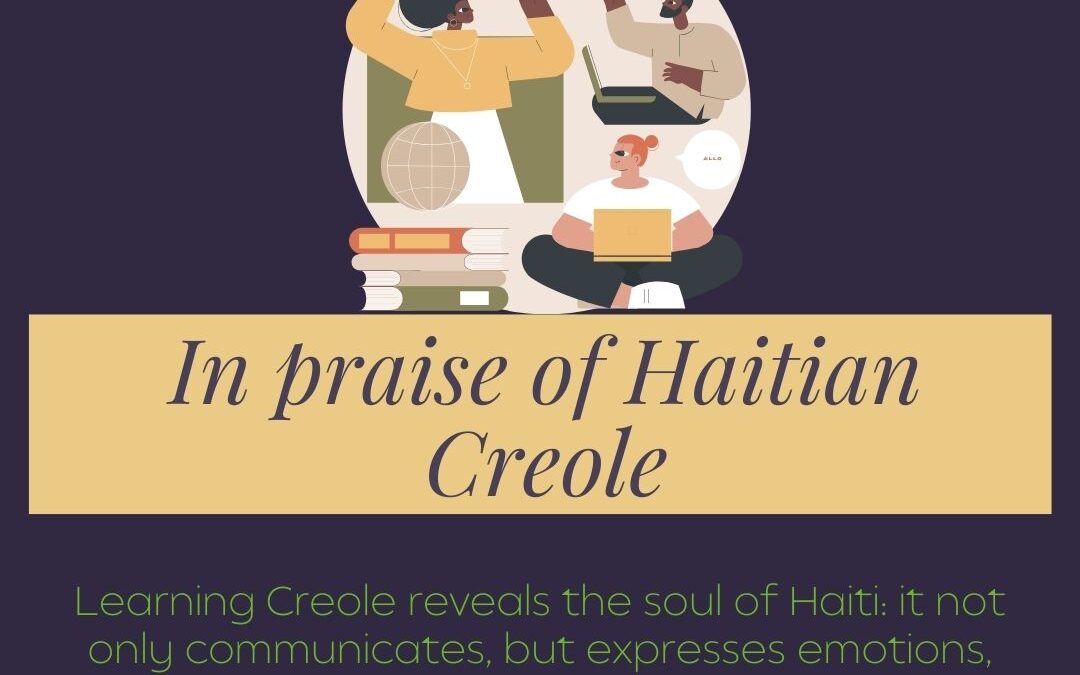By Claudia Alavez
As someone who has learned Haitian Creole as a second language, I have discovered that this language goes far beyond simple communication; it is an open window into the soul of Haiti and its daily life. This language not only conveys words, but emotions, images and ways of understanding the world that, for those of us who have a colonial language as our mother tongue, are a true revelation.
In the “white adaptation manual,” I have shared and advised: “Learn the language of the non-white: Kreyòl pale, Kreyòl konprann.” This call highlights the importance of learning Creole, not only to communicate, but to truly adapt to life in Haiti, understanding the social and cultural dynamics that cannot be fully expressed in another language. Below, I want to share five lessons I have learned from speaking Haitian Creole as a second language:
1. Uniting, not separating
One of the first differences I noticed is in the use of personal pronouns. In Spanish, we find “he” and “she,” a constant categorization that seems to put boundaries around people and their actions. In contrast, Creole, with its pronoun -li-, offers a flexibility that transcends gender. This characteristic not only simplifies communication, but also allows us to focus on the facts and not on the identity of the person acting. This aspect is deeply interesting from a political perspective, especially at a time when in Latin America debates about inclusive language are on the rise. While in Spanish these discussions continue to divide, Creole already offers, effortlessly, a bridge to transcend the sex-gender category.
2. A more direct and sincere form of communication
Creole is a language that facilitates clear, direct, and at the same time deeply visual expression. Although it is a language of images and is camouflaged depending on the context, the use of these images allows us to reach the feeling or emotion in a direct and sincere way. Unlike other languages that prioritize an extensive grammatical structure, Creole has the ability to condense and simplify without losing the emotional impact of what is being communicated.
An example of this efficiency is clearly seen when translating texts between languages; let’s take a page written in Spanish, if we translate it into French, the text can take up to two pages due to its more detailed grammar and spelling. However, when translating that same text into Creole, the content is considerably reduced.
In many ways, it is revealed that authenticity and human connection do not require complex words, but powerful and well-chosen images that speak for themselves.
3. Contemplating and enjoying the pleasure of speaking
One of the most profound experiences I have had is the ability to contemplate and enjoy words themselves. I am still moved by the expression *lapli ap tonbe* (the rain is falling, would be the faithful translation). In Creole, rain is presented as a being with agency, an entity that acts. This image turns the experience of rain into something almost spiritual, as if we were in a conversation with nature. In English, we say “it is raining,” but in Creole, -lapli- takes on a special prominence. It is as if the language is reminding us that the world is alive, and that we can connect with it in deeper, more poetic ways.
4. A new perspective on time
Time is perceived in a cyclical, non-linear way. In colonial languages like English, time is “domesticated,” always subject to clocks and expressions like “waste of time” or “you let time slip away.” However, in Haitian Creole, time seems to flow in a richer and deeper way. The use of time markers like -te, -ap-, -pral-, and -ta- allows us to think of time in a more flexible way, breaking with the rigidity imposed by colonial languages. This cyclical perception of time, present in many non-Western cultures, has allowed me to reevaluate the way I organize my days and understand the rhythms of life.
5. Reconnecting with Mexico’s native languages
Mexico is a country with more than 68 native languages, and around 7 million people speaking them. Like Creole, many of these languages have a unique relationship with time and reality. In the Otomi language, for example, what is important is not whether an event has already happened, is happening, or is going to happen, but other aspects that challenge the temporal vision of colonial languages. Although many languages coexist in Mexico, it was through Haitian Creole that I began to understand what it really means to position a language as a tool for cultural and identity struggle.
Learning Creole sparked in me a deep interest in those native languages. Through this process, I began to see another Mexico, a Mexico that, from the worldview imposed by Spanish, is impossible to fully describe or admire. Speaking Creole not only allowed me to connect with Haiti, but also to reconnect with my own country in a more authentic way.
I can say that learning this language has been much more than speaking a new language; it has been an open door to new ways of seeing the world, of relating to culture, time and nature. This language, so intrinsic to Haitian resistance and identity, has taught me that languages are more than tools of communication: they are vehicles of thought, identity and struggle. It has also allowed me to reflect on the indigenous languages of Mexico, to understand their importance and the damage that colonization has caused to their survival. In a world where dominant languages continue to impose their vision, learning a language like Haitian Creole invites us to open ourselves to other ways of being and existing. Because, in the end, languages do not tell stories, but rather create realities.

